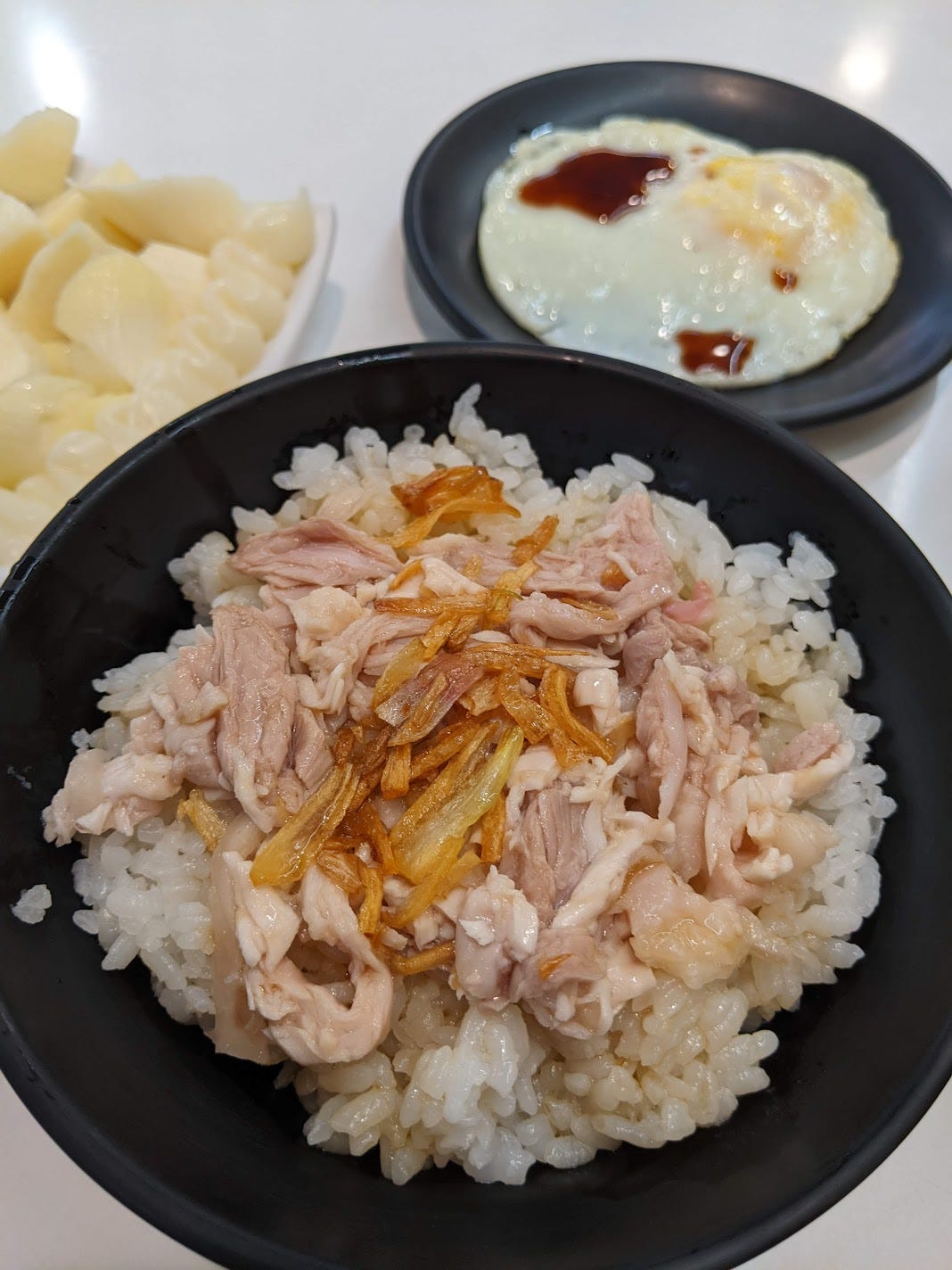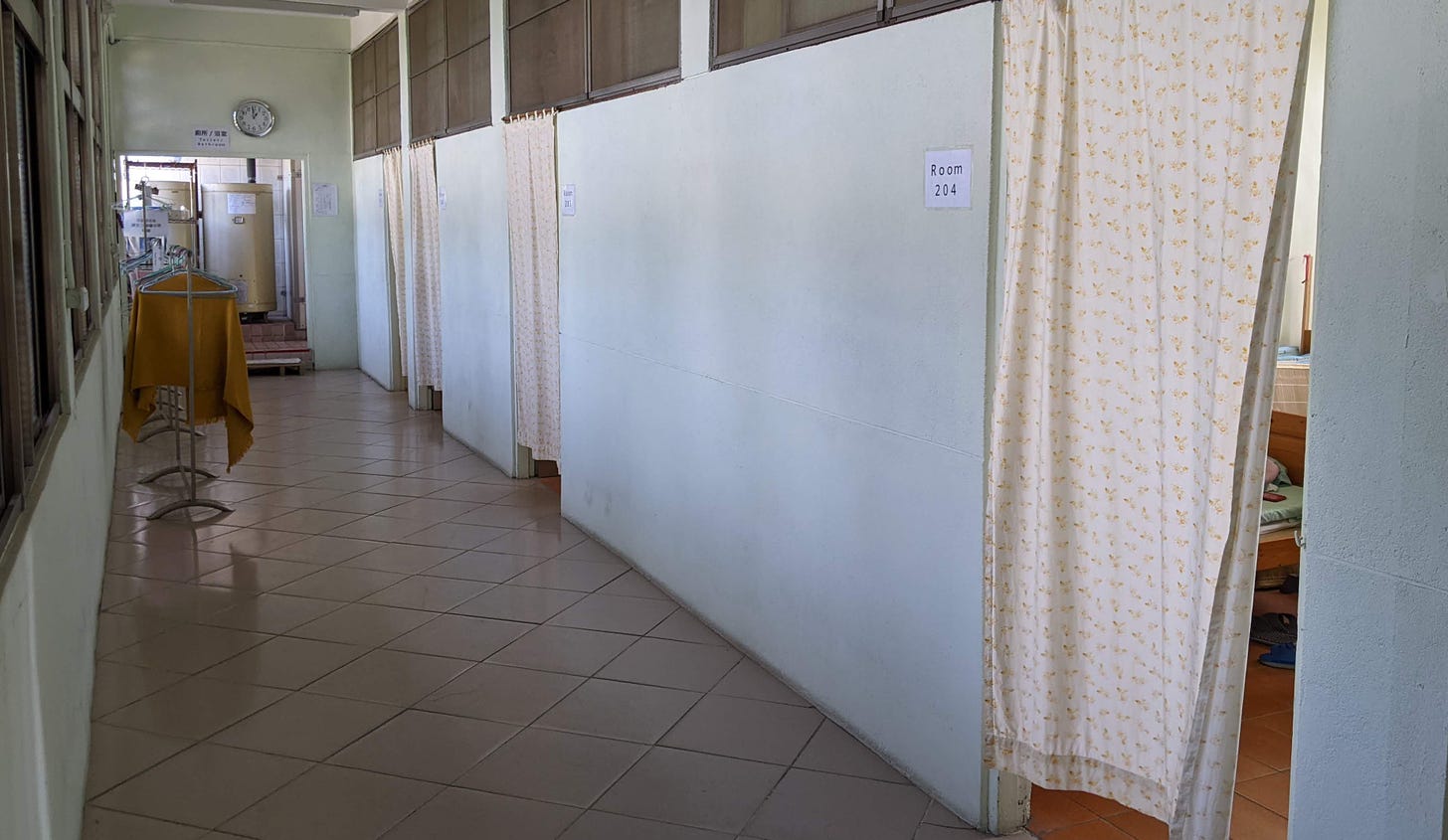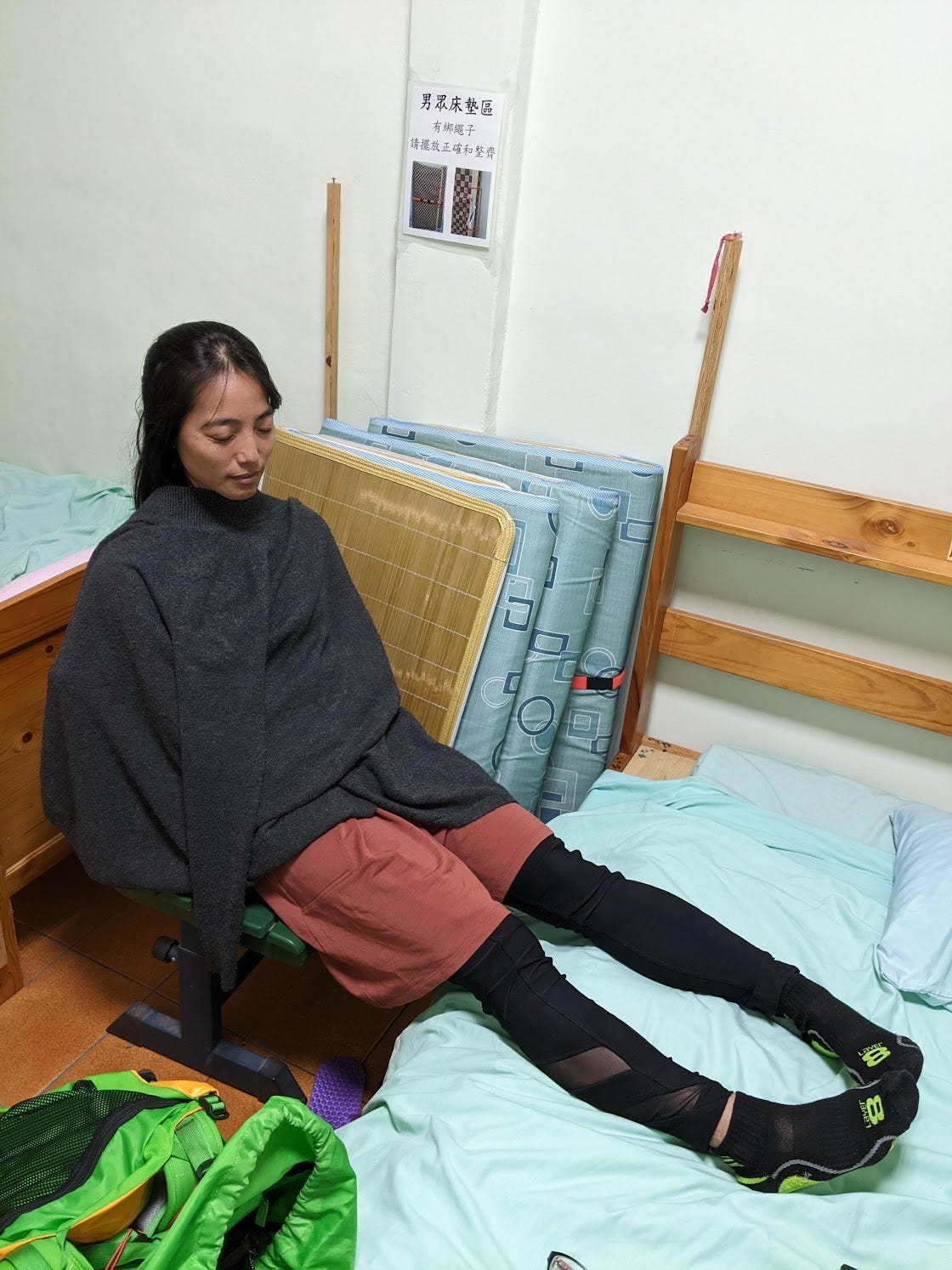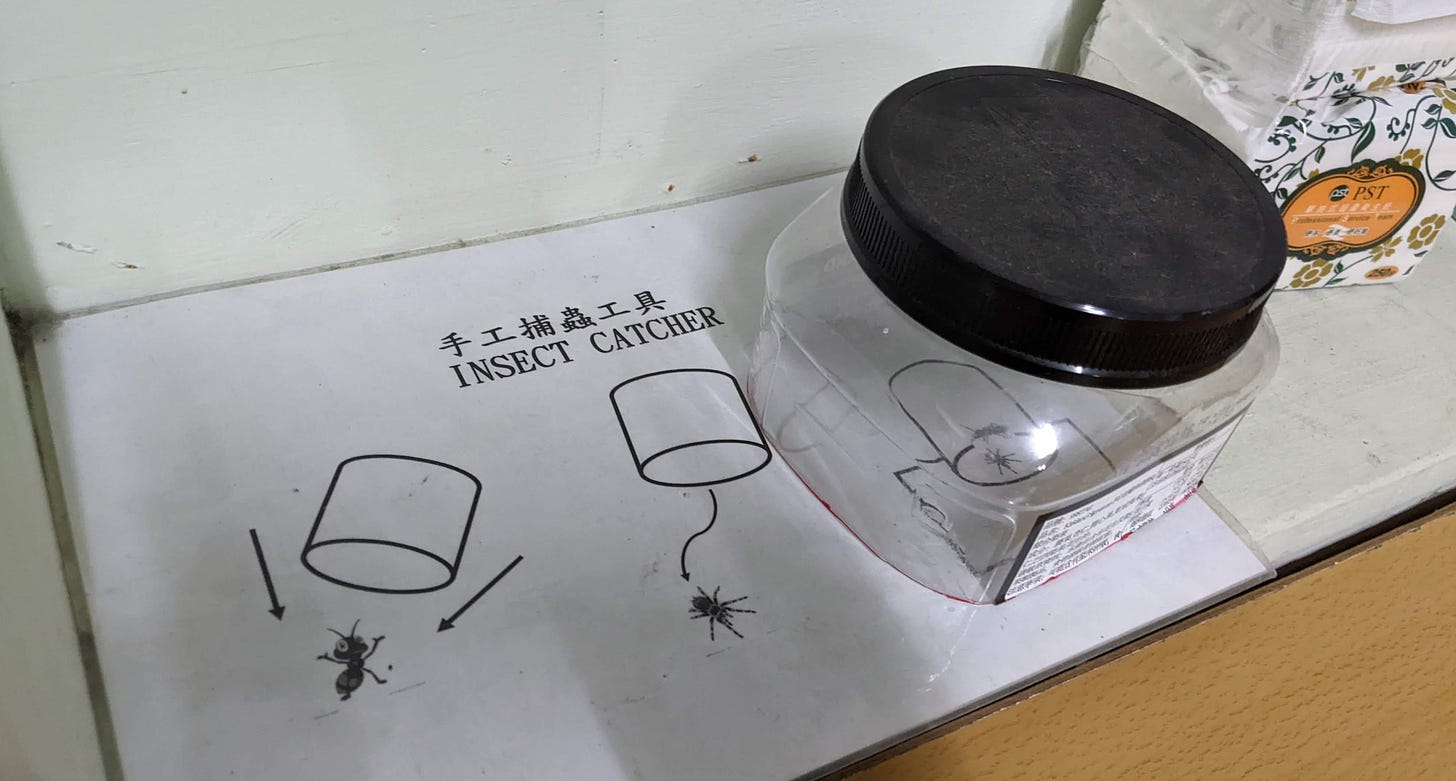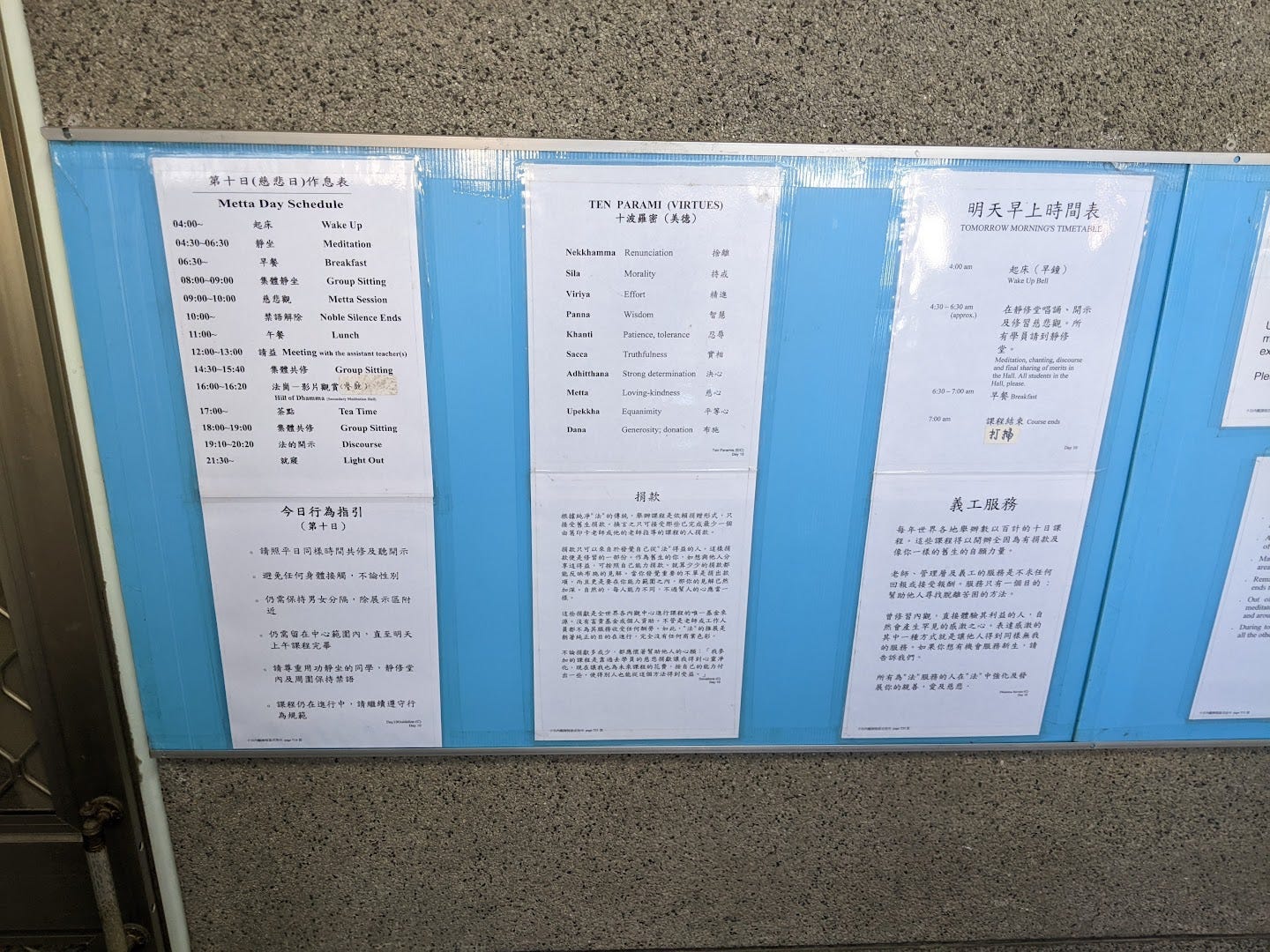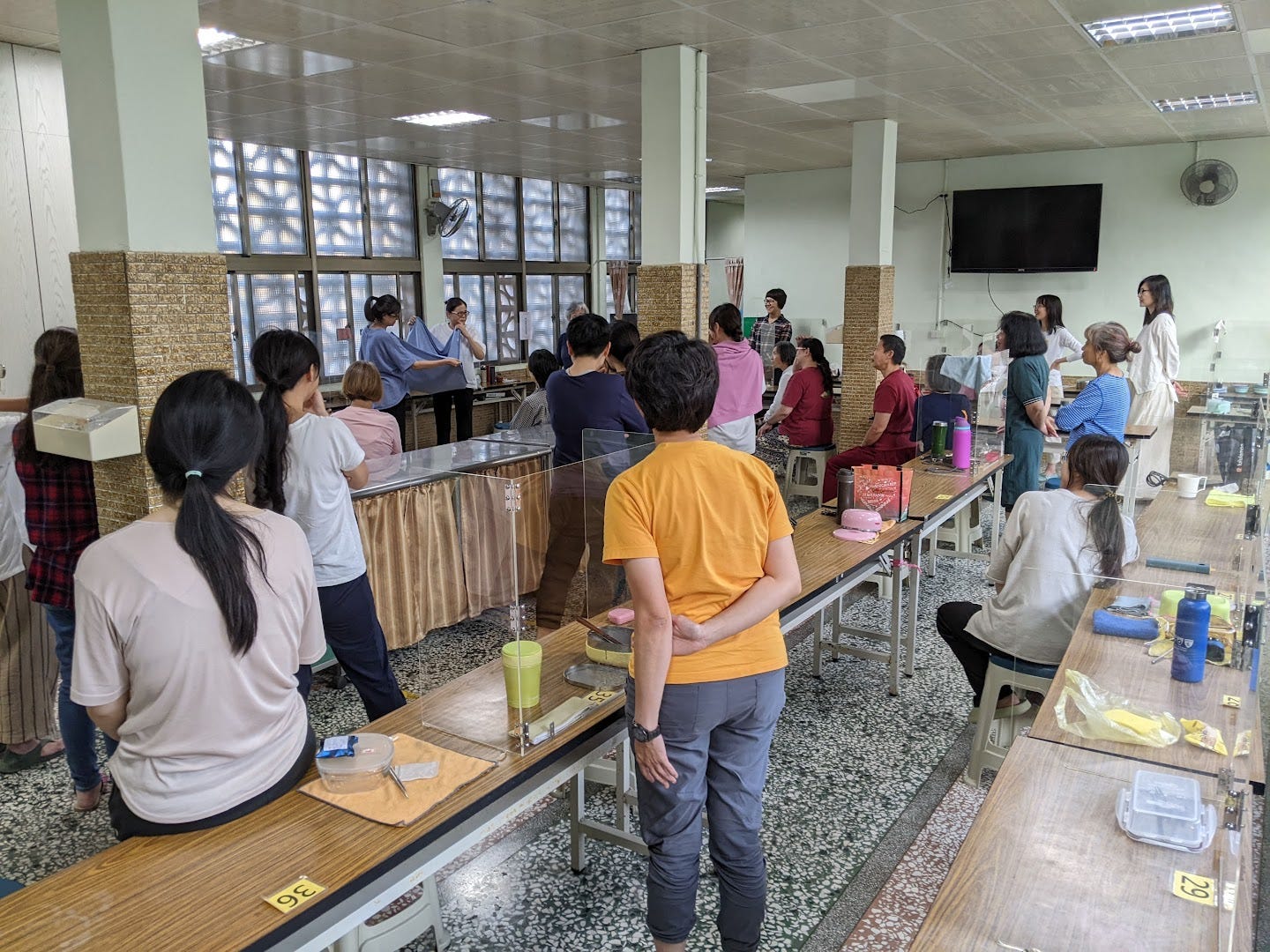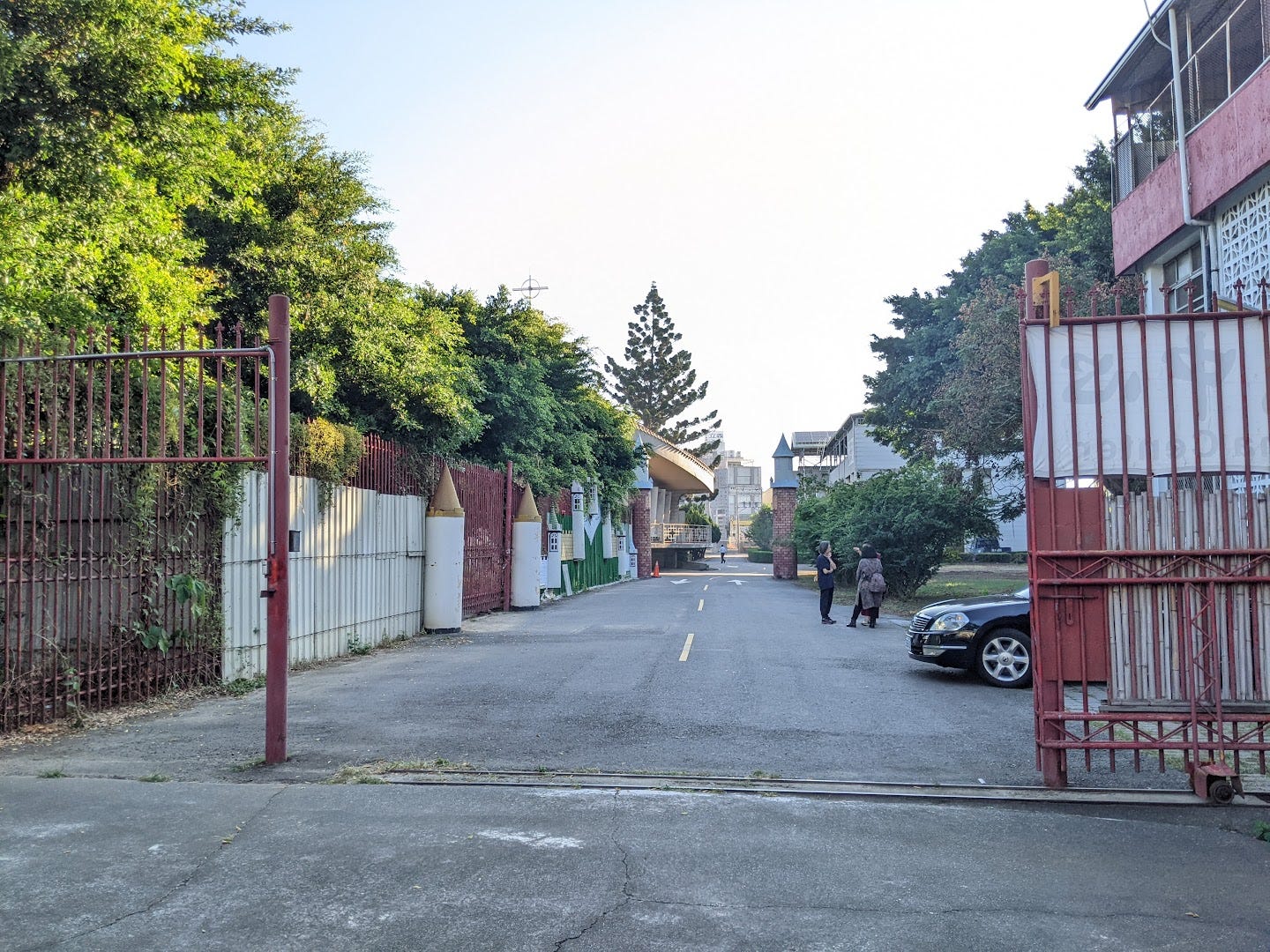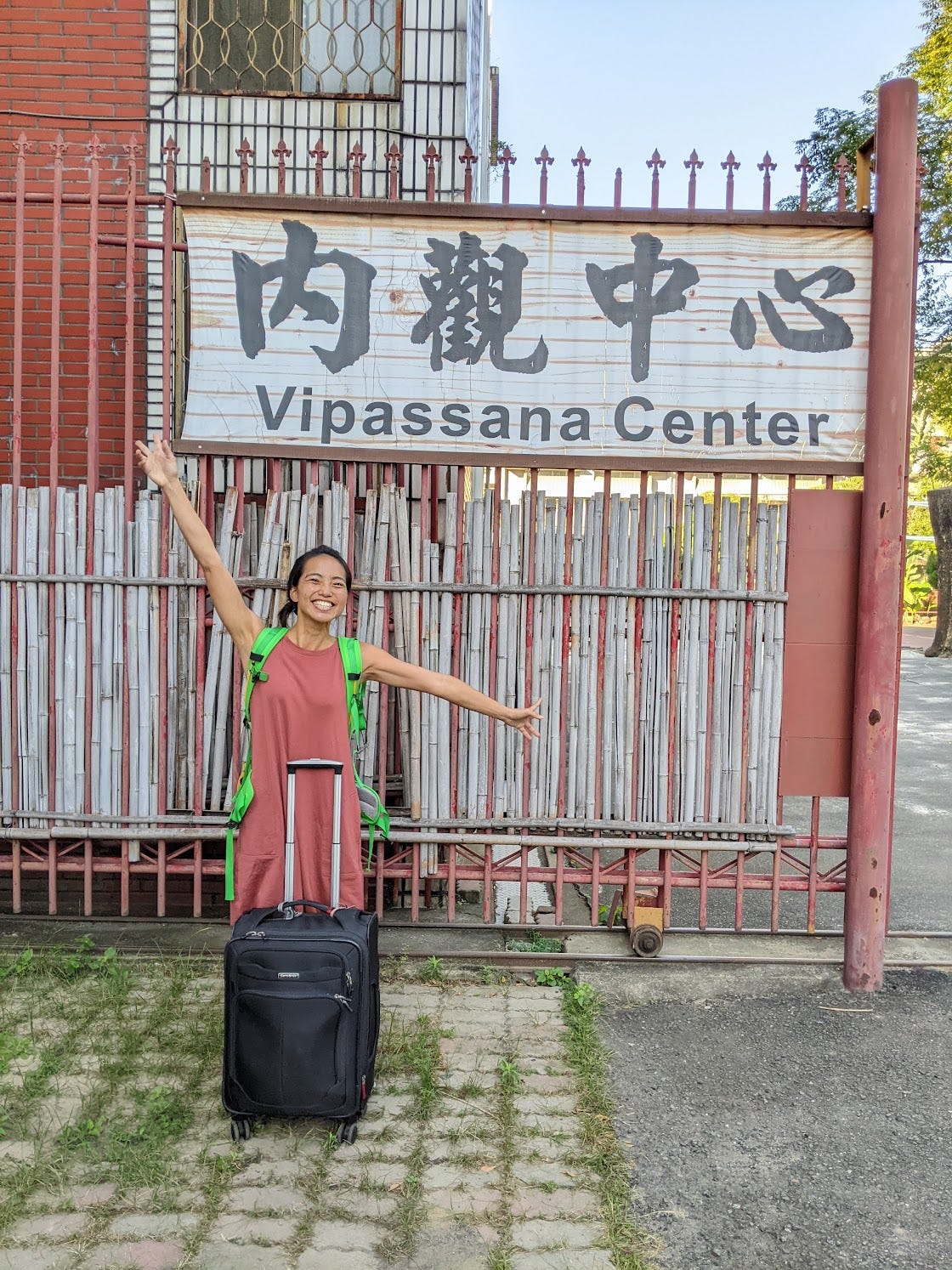10-day Silent Meditation in Taiwan | Vipassana 在台灣嘉義內觀中心的感想
Developing awareness and a balanced mind 找回 覺知 與 平等心
At the end of November, I went to a Vipassana Center in ChiaYi, Taiwan for a 10-day silent meditation program. Seems only natural as I continue on my spiritual journey. No cell phones, no talking, no writing, no reading. We were about 40 women, a mix of former students, new students, and volunteers. For those 10 days, we shared the space within the building, serving as the dormitory, dining hall, and Dhamma Hall. But we were not allowed to interact or communicate with one another; this meant not looking each other in the eyes, not saying thank you or sorry or excuse me (this proved to be tricky for me), and certainly no hugs or handshakes or smiles of acknowledgement. We could talk to the course manager on practical or logistical manners, and we could sign up to talk to the assistant teacher during designated times with our meditation questions. But other than that, we were to be contemplative.
十一月底我去嘉義的內觀中心進修了十天。沒有電話,不能講話,不能寫東西,也不能讀書。我們有差不多四十個人在一個空間(宿舍,餐廳,法聽),但完全不能交流。我有很多感想,用英文表達比較容易。
Several people in my circle are very curious about my personal experience, so take this longwinded essay for what it's worth. I’m just one person, led by curiosity, encouraged by people I met this year who had nothing but great things to say about their Vipassana experience. If you’re at all curious, I encourage you to sign up.
I came with zero to no exposure to Vipassana meditation and really didn’t know too much about the daily routine of what I was signing up for. For example, I had no idea I’d be waking up at 4 am until my cousin told me two weeks prior to my start date.
Instead, I had big hopes that this would be an effective way to calm my nerves and anxieties. Before I left the East Coast in mid-October, I told my a psychiatrist-friend-meditator, “This is my last ditch effort before I turn to meds.” For what it’s worth, being in Taiwan for the past month has been another layer of integration I’ve likely needed. It’s paired well with my years of going on my inner work journey (with significant help from my therapists), reading about mental health (so much good material out there), and building my self-care toolkit (really fun to experiment!). As such, I think I went into Vipassana with a much healthier and clearer headspace than when I signed up.
It’s a lot of time sitting and meditating. And if you have a chatty mind like mine, it’s pretty much impossible to quiet it to zero. After the first few hours, I gave up on trying to be good at meditating. Like much of what I’m trying to do with my life, perfection is no longer a goal or an expectation. I was simply striving to finish these 10 days intact.
An interesting note about doing this course in my less-than-dominant language is learning that “mind” isn’t what I thought it meant. I always thought mind meant the head, the brain, the thoughts. But I have it all wrong. Translated into Mandarin, “mind” is translated as “心.” But “心” means heart, so thus feelings and emotions, right? It turns out, in meditation, mind and 心 mean “consciousness” and “aggregated awareness.”
I don’t exactly know what this means yet, but I’m walking away with the intent to develop the awareness to align my thoughts and feelings, balance this “mind” without self-judgment. 找回 覺知 與 平等心. For whatever that’s worth. For better or worse, this is to be a work-in-progress for life.
What I Loved
There’s much I loved about the ten days in captivity: head clearing, food, simple routine.
I loved the simplicity and routine. Each day pretty much followed the same schedule. Wake up early, meditate, eat, break, meditate, lunch, break, meditate, tea break, meditate, go to bed early. The only responsibility we each had was to wash our own dishes after meals, shower, wash our own laundry, and show up to meditate. All other forms of distractions are removed.
I love the concept of a retreat. With the physical essentials covered, it’s an opportunity to slow down and tune into what is trying to come up internally. I was afraid that this would raise up unprocessed emotions, from breakups and the like. But instead, my subconscious served up (mostly) pleasant visions of possible dreams. Note that the point of meditation is to stay grounded in the present through a focus on the breath, so I wasn’t really supposed to visit the past or imagine a future. I did let it play out a little longer than they normally would have in a walking meditation or in a sleeplike dream, before returning to my breath. The opportunity to dream big without my judgmental voice piping up was a treat in itself.
I loved visualizing things, and not having a mean, self-critical, or judgmental voice chime in before the “What if” scenario played itself out. Because there was so much time on the cushion and I had no watch, I couldn’t use time as a constraint. Impatiently waiting for the dismissal just made time stretch out longer. But if I let the vision play out, I could also tune into how I was feeling. And I could ask, “What next”? And since I couldn’t write anything down, I just replayed parts I was curious about. This also seems to be in violation of the Vipassana rules, which emphasized not holding onto anything, and this included both good feelings and bad feelings.
I loved breakfast and lunch. The volunteer cooks are incredible. Both meals were freshly made, served hot and on time. Each vegetarian meal was crafted with love and infused with different seasonings that perked up my taste buds. Utterly delicious. I had some digestive issues from a month of eating unhealthily in Taiwan, and within five days in the Vipassana Center, I was back to normal.
Before eating, I took a moment to intentionally ground myself. With hands wrapped around my bowl, I’d feel the heat of the food radiating into my palms and feel the love that went into making said food. Since before my nephew (one of my best friend’s son) could talk, we’d hold hands before meals and take three deep breaths in and out, followed by “itadakimasu!” (Japanese phrase meaning "I humbly receive," used before eating a meal). It works wonders. I practiced this on the Camino with me as well, and here again at the Vipassana Center.
What I hated/disliked/growth edge
I feel terrible admitting this at all. So perhaps I should call this a growth edge, rather than what I hated. Despite loving everything mentioned above (and much more detailed below), there’s one thing I couldn’t get over: Goeke’s recordings. The recordings are from the early-1990s, but he could have really benefited from having an audio producer, a speech coach, and a singing teacher.
In full transparency, I absolutely couldn’t stand the recordings. It’s auditory assault for anyone who has had an ounce of musical training. Perhaps he doesn’t breathe or sing from his diaphragm because he is too focused on breathing in the triangular section between the nostril and upper lip. As any wind instrumentalist would have heard time and again: resonate down so the end of a musical phrase doesn’t sound whiny. I can shut my eyes and my mouth, but I can’t shut my ears.
I also disliked that there wasn’t a lot of trees or grass here. Supposedly the new center (currently under construction) will have much newer everything.
Would I do it again?
All in all, I’m glad I tried this course. I’m honestly not sure I’d do this form of Vipassana Meditation again. The auditory assault was near-unbearable for me. I’d consider volunteering as a cook so I could learn to make a variety of vegetarian dishes. I’d consider a one-day or three-day course, because who wouldn’t benefit from some digital detox and silent solitude? If I had ten days to spend at a retreat, there are several other ways I’d prefer to spend it. I’d like to come out feeling energized from insightful conversations and in tune with nature, rather than feeling thankful I tolerated and survived.
« Spoiler Alert »
Feel free to read on if you’re curious about the more minute details of my personal experience. But if you want to be surprised when you experience it for yourself, stop here!
如果你有興趣參加內觀中心,不要往下讀!
The Signup Process
I first heard about a 10-day silent meditation retreat from an acquaintance, who went after filing her divorce papers. It was around the time I was going through my engagement breakup, and I was seeking as much help as I could to feel better (physically, emotionally, mentally — the works). I didn’t think I could take the time off of work, and if I did, I’d rather go travel. Moreover, I knew I wouldn’t be able to sit through hours of silence, battling my own (very mean) thoughts. So I filed it away as a point of curiosity to probe later, but not something I could possibly try now.
After getting back from the Camino early this year, I actually tried signing up at a Vipassana Center near Boston. However, it was always full for Newbies and I never made it off the waitlist. So I forgot about it again. Maybe it’s not my time yet. While talking to a neighbor-healer-friend, she mentioned that I should look at sessions in Taiwan. I hadn’t even thought to do that. I made a note on my calendar to sign up on the day bookings opened. And I made it in!
Note: Signups are less competitive much for Returning Students and for Volunteers (which are also Returning Students, just in a different capacity).
If it’s your first time, set a reminder for yourself on when signups open up.
However, don’t despair if you get waitlisted or don’t make it this round. One of my roommates was pretty far down on the waitlist, and got in. And the other roommate transferred in from another location. It’s like the Universe wanted the three of us to cross paths at this time. :)
Commentaries about My Personal Experience:
Day 0: I was far too excited about this mystery course I signed up for, and inadvertently ran on an early schedule today. I woke up extra early and left my apartment extra early. I arrived at Taipei Main Station a whole hour before my train was due to depart, so I changed my ticket to the next earlier train. But this of course got me to ChiaYi too early.
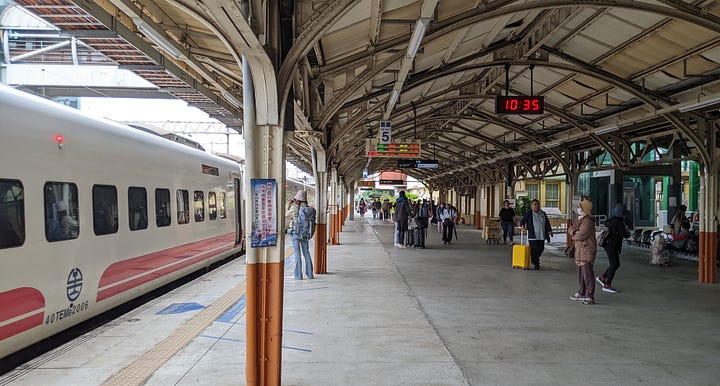
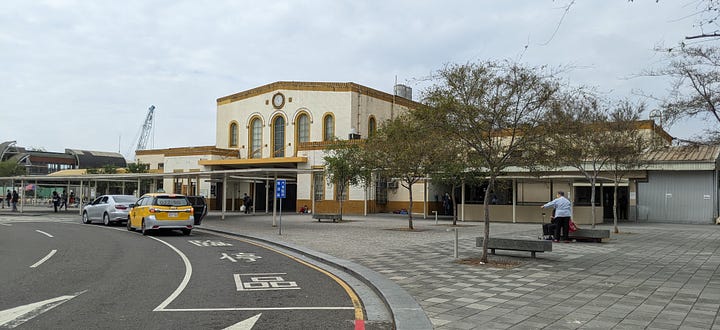
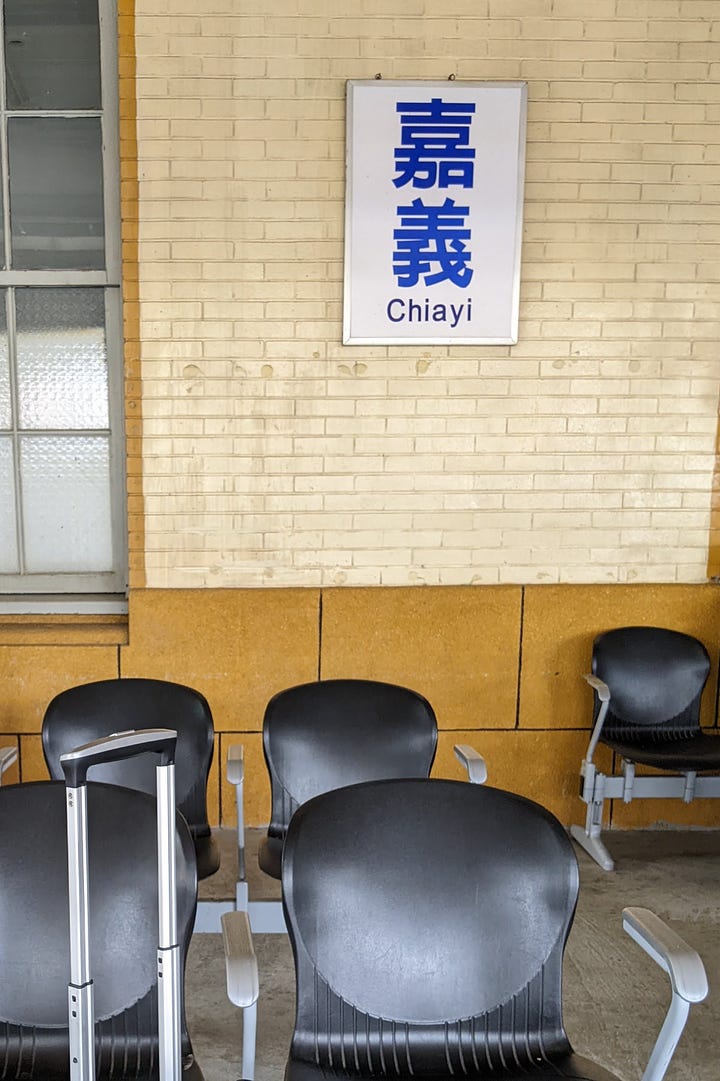
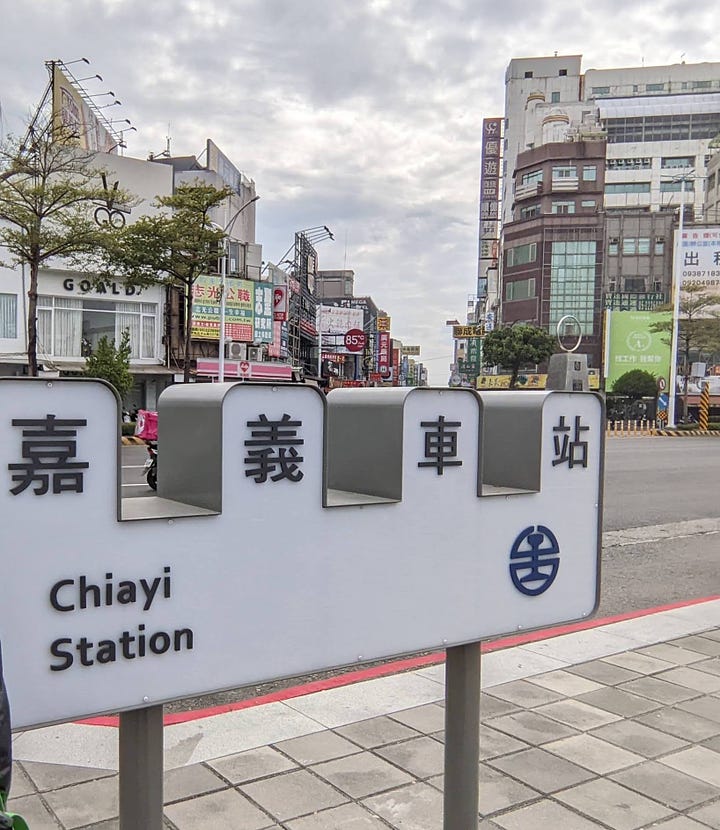
I was determined to get the infamous turkey rice dish for lunch, my belated Thanksgiving meal. The restaurant and meal carts don’t open for lunch until actual lunch time. So in an effort to kill some time, I decided to walk around ChiaYi. As it turns out, ChiaYi is not a particularly friendly pedestrian city, but I stubbornly carried my backpack and lugged my roller bag along the streets. I got my lunch: 火雞肉飯 turkey rice. It was fine, but not omg amazing. I have a new respect for fried shallots. But it’s the last meat dish I’ll have for 10 days.
I walk another few miles to the Meditation Center, and was told I can leave my bag, but that I’m too early for official check-in. So I continued my walk in search of AiYu. Google Maps is not the best at finding things in ChiaYi. The place doesn’t sell any of the three things I wanted, but I felt bad. So I ordered the only thing they offered, which I think was just what they were personally having for lunch.
I was STILL too early to check in (seriously though, when in my life do I run early?). On my walk back, I saw a massage spot open. They happened to be able to take me as a walk-in. My lucky day! I got my long-awaited foot massage and cupping on my back and neck (been hyper tight and sore). It was the plastic suction kind of cupping, which isn’t my favorite. It’s apparently no longer common practice in Taiwan to do traditional cupping, where practitioners light a fire inside the glass cup (boo!) to evacuate the oxygen to create suction, before placing the cup on your back. But she said some TCM doctors 中醫 still do it, and that I can search specifically by 拔火罐 rather than just 拔罐. Noted.
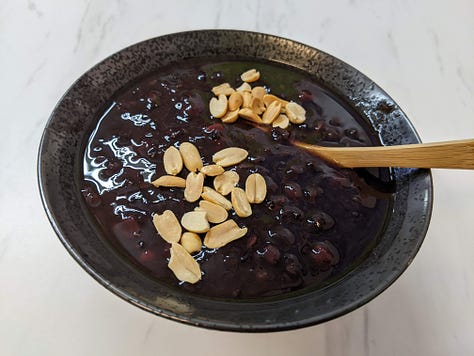
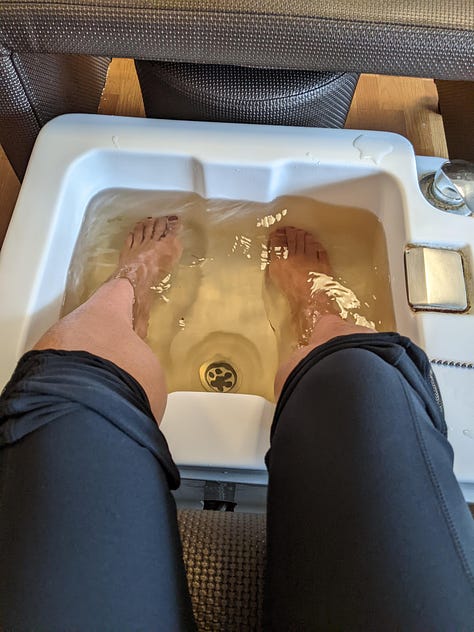
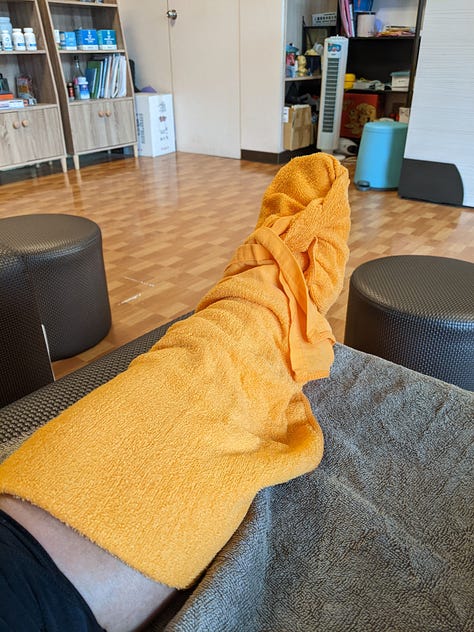
Refreshed and pre-big-event-self-care done, I walked the final block to the Vipassana Center. Plenty of people had arrived by then. To me, I was immediately struck by a familiar feeling: it’s like walking into high school nerd camp (I say that with nostalgia and pride). Everyone’s a stranger. There are new rules to be learned. Both nerve wrecking and exciting.
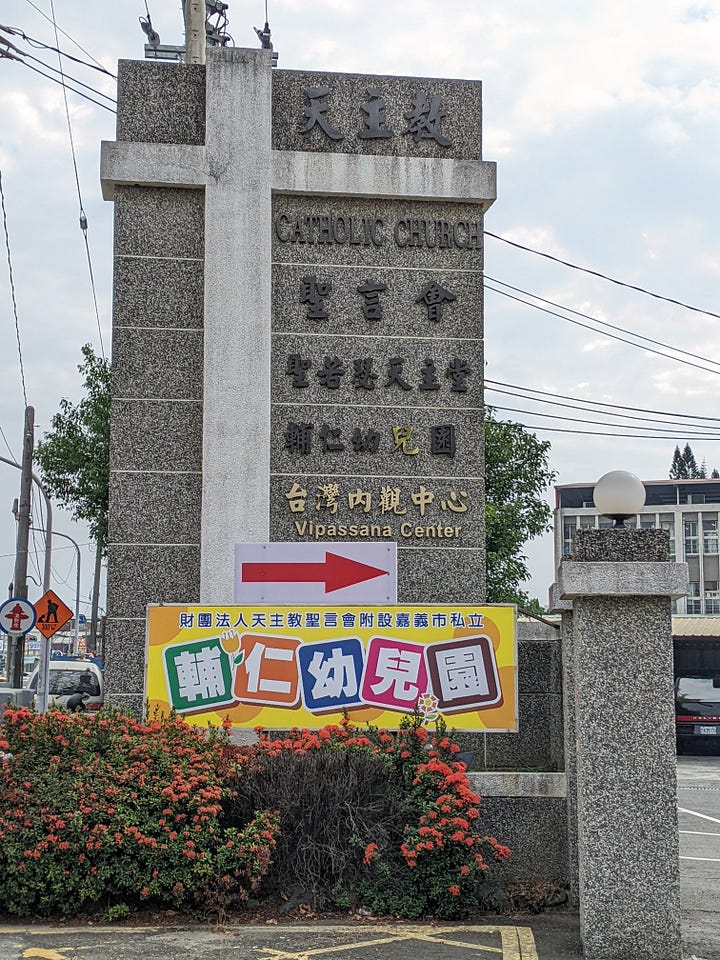
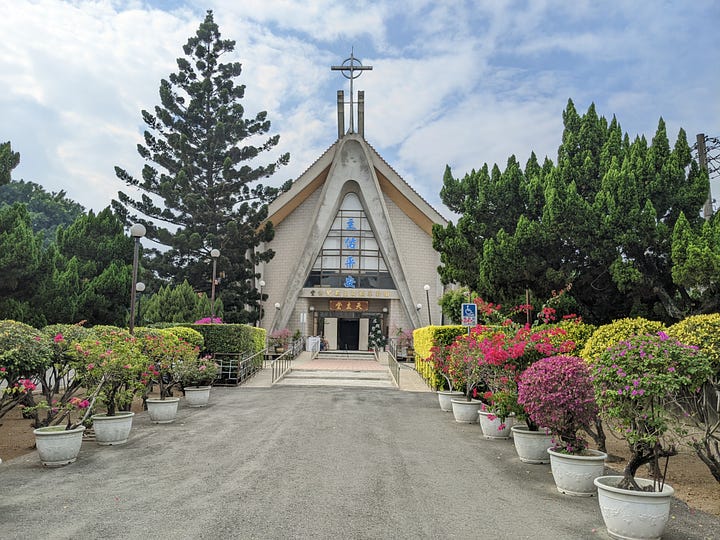
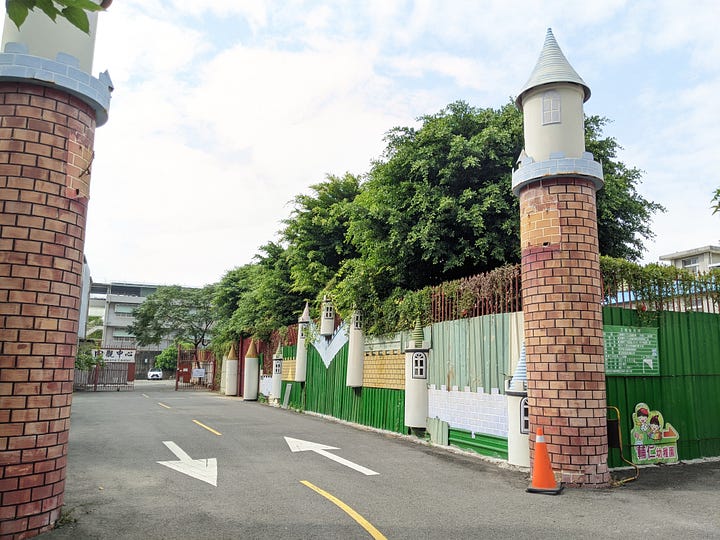
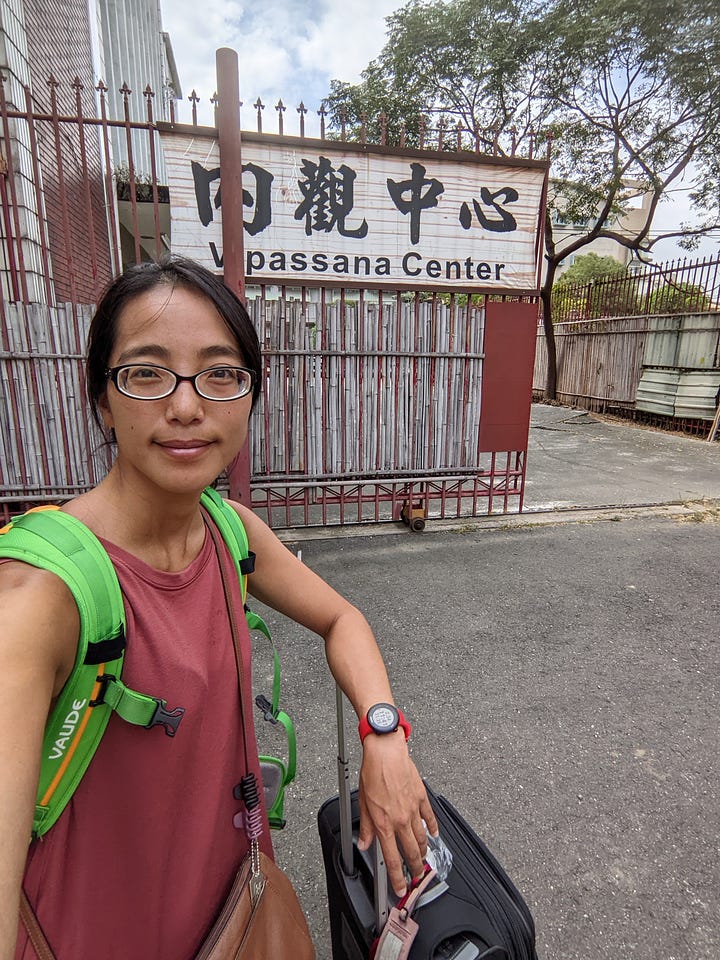
I registered and filled out the bilingual form as best as I could, turned in my cell phone and valuables, got a strip of paper that said everything from our bed number to our shower stall to our dining hall seat number. I was also told to cover up my shoulders. Right. Oops. But it’s wicked hot out.
I set up my bed, learned where the bathrooms are, exchanged names with my two roommates, gathered in the mess hall for our final dinner for ten days, listened to the introductory video, and went to the Dhamma Hall for our first sit.
And immediately upon first utterance of Goenke’s welcome chant, I wondered if I can still quit.
What a typical day looks like at the Vipasanna Centers:
The schedule is pretty much fixed and standardized throughout all the Centers around the world. Changes are dictated by gong strikes.
4:00 am — Wake up
4:30-6:30 am — Meditate
6:30-8:00 am — Breakfast and break
8:00-9:00 am — Group Meditation
9:00-11:00 am — Meditation
11:00-noon — Lunch
Noon-1:00 pm — Option to talk to teacher, break
1:00-2:30 pm — Meditation
2:30-3:30 pm — Group Meditation
3:30-5:00 pm — Meditation
5:00-6:00 pm — Tea Time, break
6:00-7:00 pm — Group Meditation
7:00-8:30 pm — Discourse
8:30-9:00 pm — Meditation
9:00 pm — Bedtime
We have the option of taking the non-group Meditation sessions from our rooms or from the Dhamma Hall. Often though, if the Meditation session follows a Group Meditation session, we’re expected to remain in the Dhamma Hall.
Days 1-3: Anapana (focus on the breath in the area below the nostrils and above the upper lips)
The first three days are focused on breathing in a triangular section, from inside the nostrils to the area above the upper lip. We were supposed to do that all day, in what summed up to 10 hours of seated meditation.
As someone who has only ever meditated for 30 minutes (guided) and 10 minutes (solo), I was stumped at how people can sit for hours without moving. I shifted around every few minutes. We were forbidden from stretching our legs forward towards the front of the hall, so my postures were limited. I’d start off criss cross like everyone else. But I’d tap out early. Change. I’d hug my legs together, placing a rolled up sweater on my knees to place my forehead. My neck gives out first. Change. I’d keep one leg bent in front, and move the other leg behind, stretching out my hip flexors. Tired again. Change. By Day 9, I managed to get two additional cushions to sit on, and be able to wrap both legs around the cushion stack. Knees hurt first. Change. I’d stealthily stretch one leg forward at a 45 degree angle. Change. Change. Change.
When does this end? I need to pee. Why didn’t I pee before coming in here?
I turned in my watch along with my cell phone and wallet. I should have kept it on me, like my roommates; the only clocks in the building were in the hallways. And when you’re in the Dhamma Hall, it’s a blackhole for time.
Lunch was great. I’m hungry again. Do we get to eat tonight?
While I could hear the neighboring middle school’s bell schedule, I couldn’t align it to my internal clock.
Oh, there’s the audio tape again. He sounds like an animal braying. For a guy focused on breathing, he certainly can’t sign worth shit. Maybe because he only focuses on nostril breathing, and doesn’t know anything about diaphragm breathing.
At each break, I’m the first to rush out of the Dhamma Hall. For the bathroom. For my bed. Until we’re called back again.
During the Day 1 Discourse, I was singled out and told they’ll play the English-version of Goenke’s talk in the dining hall, just for me. For the next hour and half, I sat on a plastic stool trying to guess through context clues why he kept saying “bullshit.” As it turns out, he was saying “posture.” I am not going to be able to tolerate this for ten days. I asked to be switched back to the Chinese translation. If I’m going to have to guess words anyway, I might as well learn new vocabulary. And I get to be in the company of 40 other humans.
You’d think that a day of sitting and not exercising would make it fall asleep at night, but falling asleep at 9 am is easy.
Days 4-8: Vipasanna.
On Day 4, the announcement board that shows the daily schedule said: “It’s Vipassana Day!” Goenke instructs us to expand our focus from nostril breathing to body scanning systematically “from head to feet, and then from feet to head.” Every group meditation opens with the same thing. Keep the attention moving, notice the sensations, know that everything is impermanent. No craving or clinging. No aversion or hatred. Awareness. 保持覺知。 Maintain perfect equanimity. 保持平等心。
Equanimity: to have composure even under stress.
I’ve started counting down the days until I get to leave. It feels a bit like week five of marathon training, but honestly, I don’t see how the next few days of Vipassana is going to get any better. The track in my head: I’m tired of listening to Goenke. I’m tired of sitting. Am I the only one who sucks at sitting? I miss hugging big trees and stepping on grass. I’m kind of tired of not talking. It’s getting close to my sister’s due date — is the baby here yet? Did we get a permit to hike Mt. Jade?
I started noticing one cushion in our neat rows of five. Then two. Were there students who dropped out? Or did they simply move from seated on the floor to seated on a chair? Can I drop out? Why did I sign up for this course anyway? What am I trying to prove?
I wanted to sit up higher, for the sake of my hips. My irritability was high. Why are there people hogging cushions and not using them? The woman in front of me has six cushions of all shapes and sizes. And she only uses two at any given time. Too bad I can’t ask her to return the extras to the box for the rest of us to take.
How many days do I have left? Am I going to feel grateful at the end? Or am I going to be extra irritable about wasting 12 days of my life responding to a challenge?
Morning
I’ve adapted to the new routine. Getting up at 4 am isn’t as horrible as I anticipated. The six gong strikes, played over the intercom, is actually quite pleasant and a lovely way to be woken up. Doing the whole morning routine and changing into the day’s clothes is the easy step. Staying awake in silent meditation for the next two hours is the tough part. I migrated between the chair and the bed, changing postures every few minutes: cross legged, stretch legged, head on my knees. I was caught twice by the course manager, on day 1 and day 2, for laying down on my bed during morning meditation and inadvertently falling asleep. Oops. I guess that’s why some people opt to meditate in the Dhamma Hall.
The 6:30 am gong signals breakfast! What a delight. It’s one of my favorite parts of the day! Breakfast is usually congee or rice, served with three veggie dishes and a variety of homemade pickled vegetables and crunchy peanuts. I love Taiwanese peanuts. It took me many days to realize the 肉鬆, common pairing to congee, is not real shredded pork or shredded fish, but some kind of vegetarian version. That’s why it feels and tastes different! Duh.
After breakfast, we have a break until 8 am. Sometimes I walk outside or do some gentle non-exercise exercise. Or take a short nap.
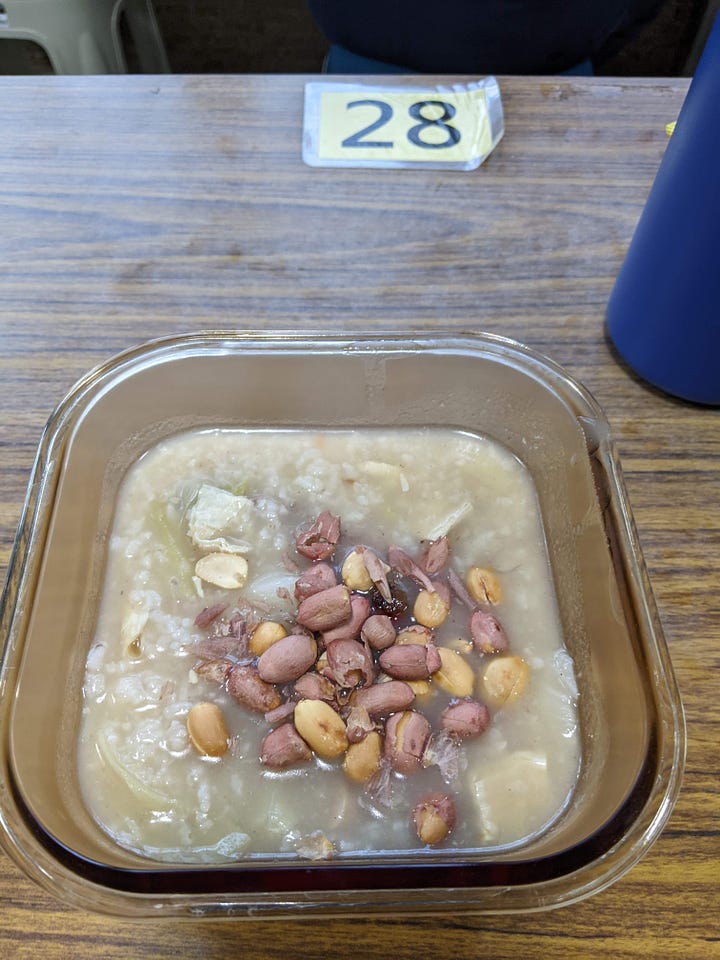
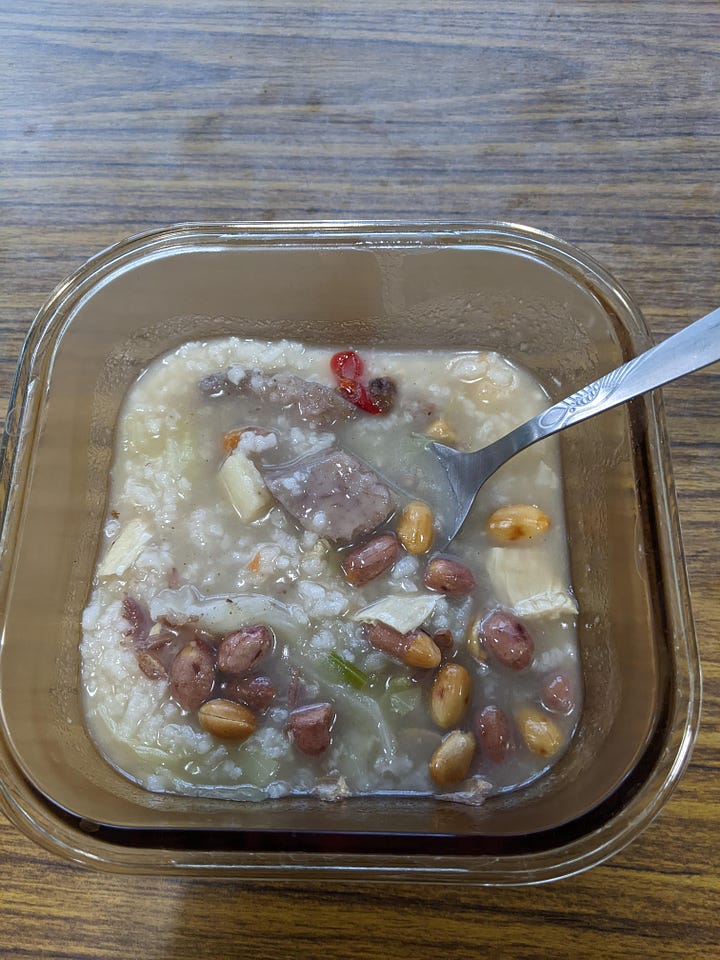
At 8:30 am, we’re called to the Dhamma Hall for group meditation. I haven’t worn my outside shoes since checking in on Day 0. It’s slippers everywhere! On Day 0, we were each assigned another number (so many numbers to remember!) indicating our meditation cushion and shoe placement. We’re required to remove our footwear and put them on the shelf, toes facing out. We leave our water bottles on a table outside, next to where the daily schedule is posted. There are two stages of curtains before we enter the hall. And I brace myself for the funky sterile smell — reminds me of a Taiwanese hospital.
Once inside the Hall, we’re not to sit on anyone else’s cushion. We each get a big cushion that demarcates our spot, with a smaller cushion to sit on, and a towel (they love towels doubling as blankets in Taiwan!). I developed a routine: socks off, towel around my legs. While in the Hall, we’re not allowed to stretch our legs and point our feet towards the front. The assistant teacher, who joins us live at the front, plays the Goenke tape.
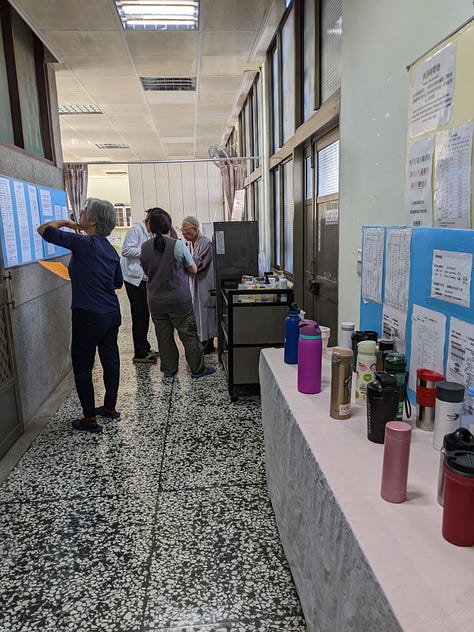
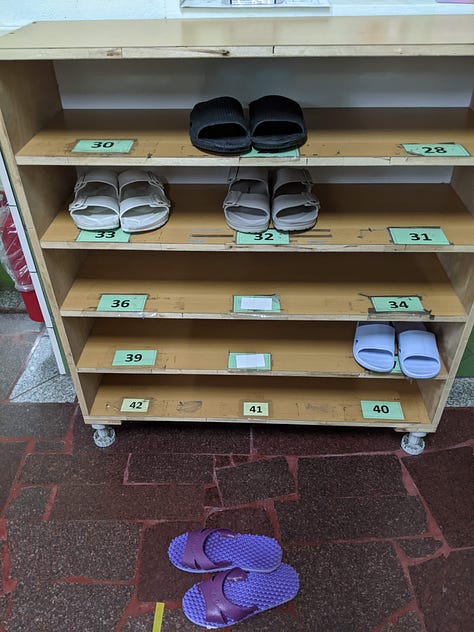
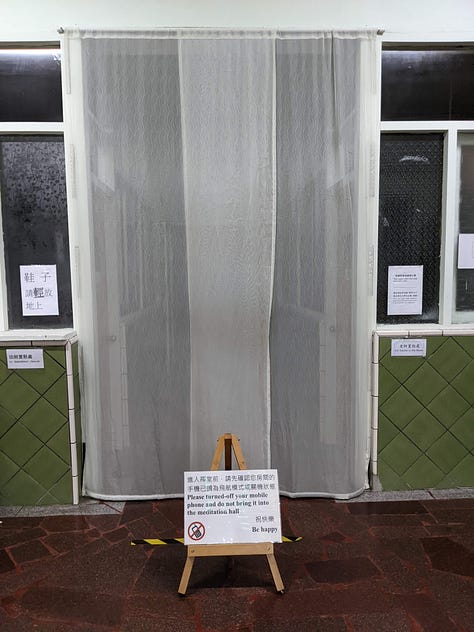
As the days drag on, the more annoyed I got with Goenke’s voice. His instructions were repetitive, but not very helpful. His chants were awful. I tried plugging with ears, but I could still hear everything. In one day, just group meditations and discourse alone, we get to hear Goenke talk or sing at least twelve times. I count down from twelve. The reprieve for me comes when the Mandarin translator pops on the tape. At that point, I get to engage my mind in trying to guess the meaning of new-to-me phrases. Oh how I wish I had access to a pen to write these down to look up later, or had my phone to instant translate.
Only after talking with my Vipassana roommates on Day 10, and then talking with my cousin and therapist after leaving the Center, did realize I guessed several of these words wrong! Too late to change my experience, but interesting to learn nonetheless.
Here are some phrases I wish I had known going in. Perhaps it’ll be helpful to other American-born Taiwanese like me who want to take the course in Mandarin:
注意力 = attention
感受 = feeling
愉悅 = pleasant
升起 = rising
滅去 = disappear
無常 = impermanence
智慧 = wisdom
平等心 = equanimity
貪求 = greedy
厭惡 = disgust
覺知 = awareness
理論 = theory
After the group meditation, we’re supposed to have another two-hour block of meditation, in our rooms as an option. I looked forward to these times so I can layout on my bed. The assistant teacher first performs a round of smaller group check-ins. How are you holding up? Are you able to feel the sensations on isolated body parts?
I nodded along. But luckily, other people were pretty honest. I wasn’t the only having some difficulties. Like me, they were hitting walls. I didn’t have the guts to admit I was getting irritated by the recordings and that I was daydreaming with my eyes closed.
I debated if I wanted to ask my question. I was potentially outing myself and my language abilities and my lack of meditation experience. I didn’t want to get sent back to the dining room to listen to the English tapes by myself. But since I have another week here, I might as well get clarification! I mean, maybe someone else was also confused? Highly unlikely.
Given English is my dominate language (the one in which I did K-college in), I picked up in the Mandarin translation (despite being my first language, it’s my non-dominant language since I didn’t grow up in Taiwan) something that didn’t make sense. During one of the check-in sessions, I ended up asking about some verbiage confusion I had.
I always thought “mind” meant brain or thoughts. But here, they translated “mind” as “心.” But “心” means heart, and heart means feelings. Which is it? The assistant teacher says it has nothing to do with thoughts, that I need to think about it as “consciousness” or “aggregated awareness.” Hmm, ok. More confused, but I’ll think on it.
Lunch
At 11 am, we get to eat again! I love mealtimes, and especially love the food here. An absolute delight. Lunch is white or purple rice with three veggie dishes and soup. With it are Costo-bucket-sized peanuts, walnuts, and cashews to add as extra crunchy toppings. Fruit is available to new students only — and this alone made my day. Every day. In the ten day span, I ate apples, bananas, persimmon, dragonfruit, tangerines, baby tangerines, and guava. A delight!
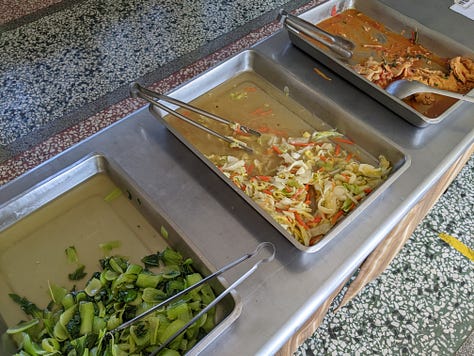

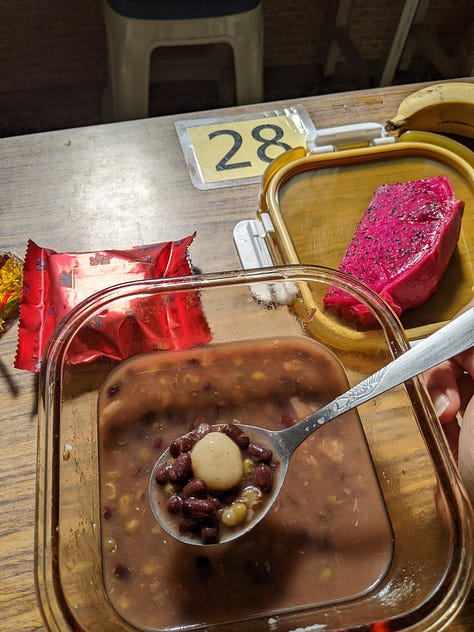
Students have the option to make an appointment with the assistant teacher from noon to 1 pm. I thought about signing up, but don’t. Without Google Translate, I’m not sure if I would know how to write all my questions in Chinese. And we’re supposed to refrain from philosophical questions, and keep the questions to only what we’re struggling with meditation-wise. I couldn’t risk admitting I couldn’t stand the audios.
We had several unstructured break times during the day, which we could spend in our rooms or outside. The breaks after meal times are the longest, up to thirty minutes; the ones between meditation sessions are typically five to ten minutes. The break following breakfast is when the air is still cool and still relatively peaceful and quiet. The break following lunch is also when the middle school next door is making lots of intercom announcements, and the sun is straight up overhead. The break following tea time nice as well, as there’s some shade along the benches and we can see the edges of the pink sunsets behind the kitchen.
We aren’t supposed to have contact with the outside world — physically or digitally. The outside space was clearly marked, effectively geofencing us in a smaller-than-a-basketball-court space. There were only a few trees that provided a little shade. My biggest complaint is there not being any grass. On one of the days, I sat on a bench and just watched the bees pollinate. I’ll take what I can get.
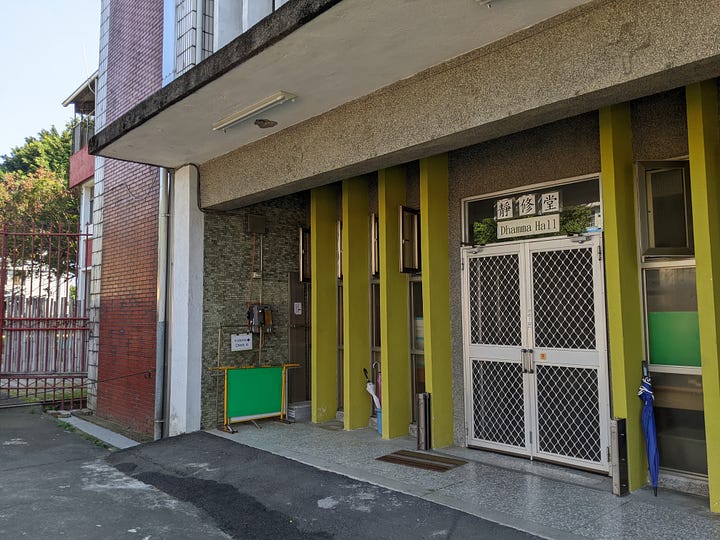
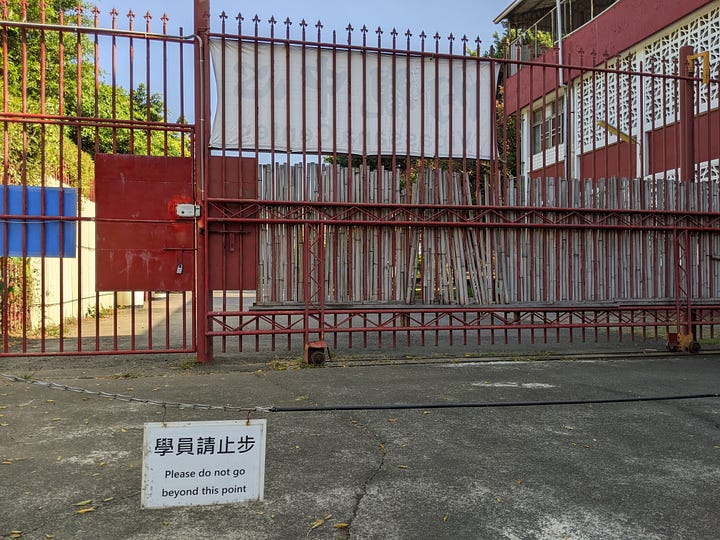
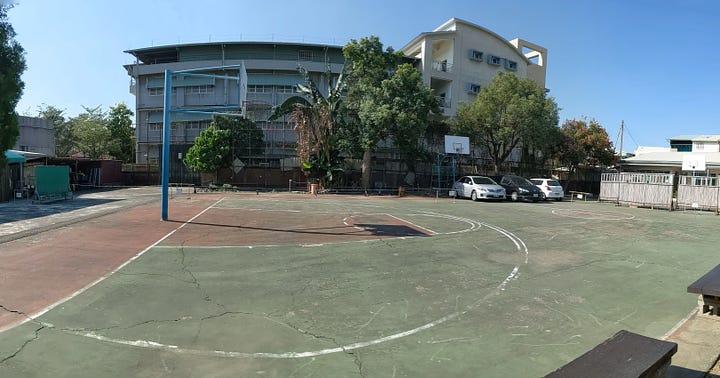
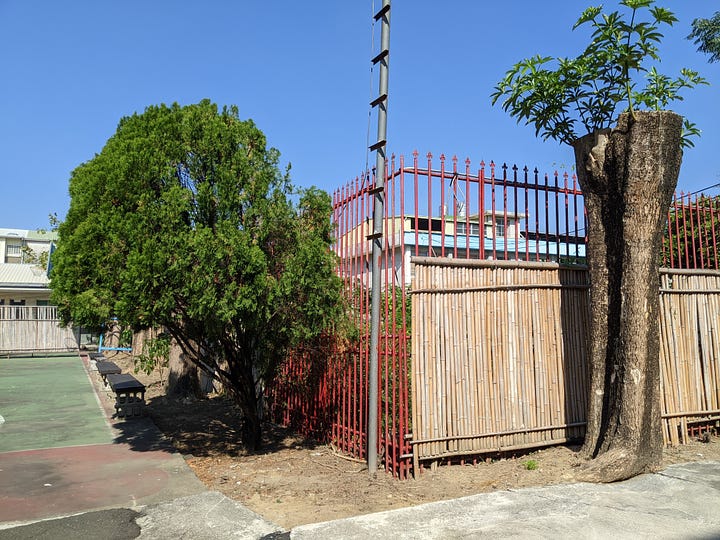
During my post-lunch break, I “exercise” for 30 minutes before my assigned shower time. In my snobbery, I never think 30 minutes is enough time for decent exercise. Goenke’s rules forbid students from yoga, jumping, running, and bouncing. So, we had to get a little creative. I was actually quite amazing by what one can do in a 30 minute block, and feel loose overall and some soreness the next day.
Walking: forward, backward, grapevine, walking lunges
(imperfect) ballet: plies, grand plies, tendus, rond de jambes
Some physical therapy exercises: calf raises (my PT would be proud), stretch band for my rotator cuff (75% recovered at best), hip openers, RDLs, standing spine twists
Sometimes, delivery drivers would stand on the other side of the red gate waiting for someone to receive the delivery. We’re not allowed to interact. I wonder if they think we’re all a bunch of weirdos, walking in circles, not talking.
Despite reading the shower chart multiple times, I still totally messed up my assigned shower time and stall number by matching my Dining Table number instead of my Bed number. So for the first few days, I inadvertently took someone slot. Oops. And I couldn’t even apologize until Day 10!
But because I went to the wrong shower, I discovered a bank of Western style seated toilets. My side of the hallway had only squat toilets. Toilets — a big thing for me.
The pipes and water heater systems are old, so it was tricky getting the temperature correct for showering. In the stalls I mistakenly used, it would flash between burning hot and ice cold. My assigned shower stall was nice because it was less finicky and had hooks! Ah the little things.
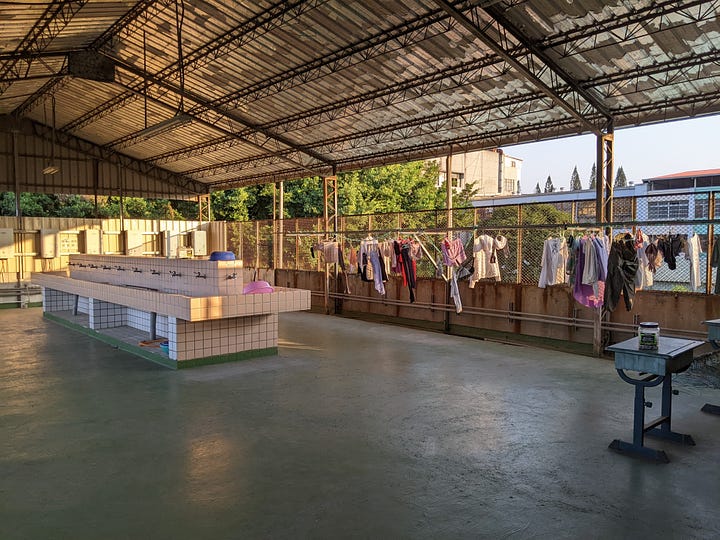
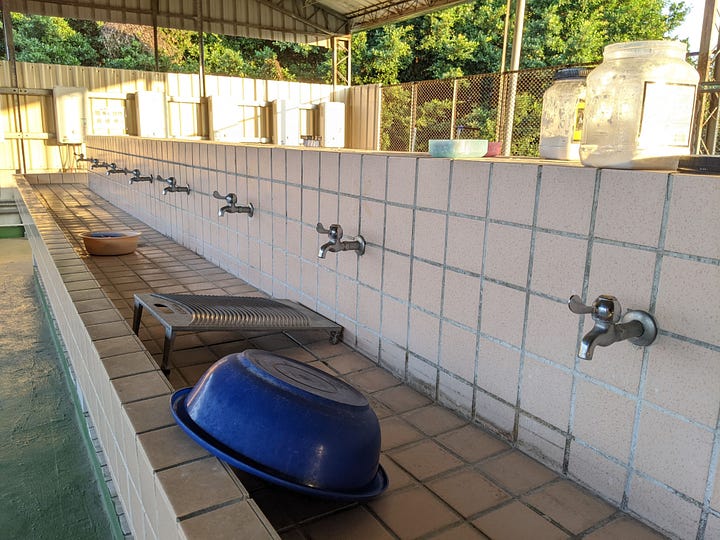
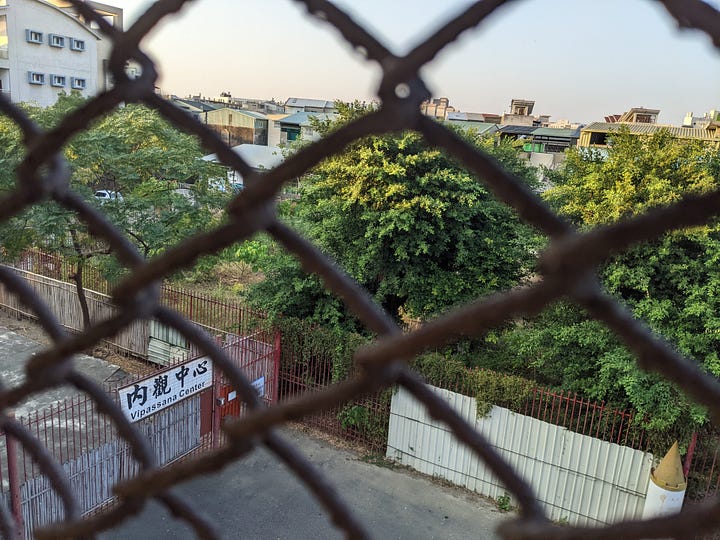
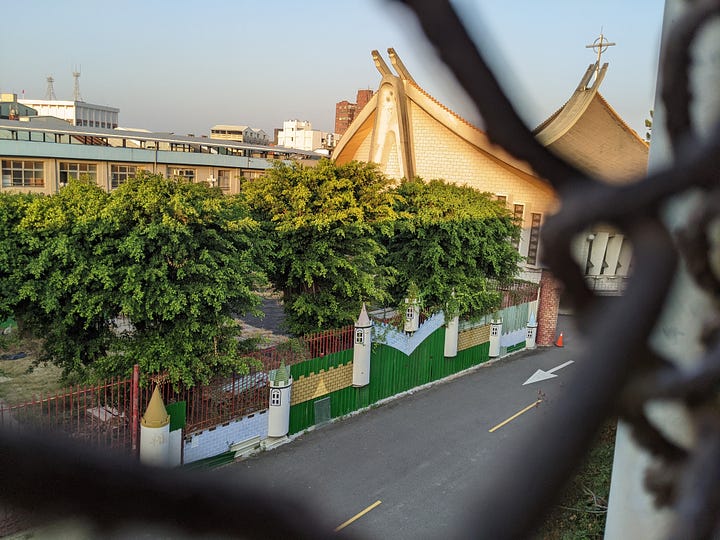
Laundry was on the third floor, a covered sunroof. There was plenty of sink space and buckets, laundry soap/powder, and hangers and clothespins. Much like on the Camino, we hand washed our own clothes and hung them up to be air dried. The “laundry dehydrator” spinner machine was a lovely bonus! Hand washing a towel is a lot of work, like kneading dough. Without the dehydrator, my towel would have never dried. Catch the timing right and you can see the sunset on one side.
Evening
There’s no dinner, but during “tea time,” new students get to mix spoonfuls of rice-based powder with brown sugar into a soupy drink. Every afternoon, I get to recall what it’s like to mix joint compound to the just-right-consistency to fix my apartment walls. Mixing this soup was pretty much like that. Except it took me until the tenth day to figure out the right ratio of powder-to-water and how much sugar to add to make it not chalky to drink. As new students, we’re also allowed to eat fruit. Returning students get to drink only lemon water. I thought I’d be a hangry mess without dinner, but it was actually ok. I’d go to bed on a rumbling stomach, but it was tolerable.
The Center we’re at in ChiaYi is a temporary facility while the main one is under construction father in the countryside. Meditating in the afternoon posed some challenges amidst the audio pollution that’s endemic of Taiwanese cities. From our bedrooms and from the Dhamma Hall, I can hear all sorts of interesting things:
Delivery trucks backing up and blasting: 倒退,親注意安全
Children screaming from the nursery next door
Church music blasting from the church across the street
Middle schoolers getting called over the intercom interspersed between music, which I think was the signal of classes changing
Infamous Taiwanese trash truck music playing on repeat from 5 pm until bedtime
Bedtime
The bed was not comfortable. This was a Goenke tenent: “no luxurious beds.” The base mattress was thin and on top of that we laid a second bamboo mattress. The sheets were too short and the bamboo strips kept poking out. The duvet wasn’t long enough to cover my shoulders and feet at the same time, so I took to wearing a fleece jacket to bed.
I’d wake up in the middle of the night with mosquitos buzzing around my ears. We’re not allowed to kill insects. I ended up with lots of bites on my face and eyelids that I didn’t notice until after I left the Center. Should have used the mosquito net canopy.
The only thing I liked about sleep was the pillow — firm and supportive.
I thought that perhaps not doing much beyond sitting and meditating for ten hours a day would cause insomnia, but sleep came relatively easily to me most nights. I would wake up in the middle of the night, anticipating the 4 am gong. But I felt more or less well-rested.
Day 9: Metta (a loving-kindness meditation)
I felt that much of the Discourses up until this day were just random, nonsequitur ideas and thoughts Goenke had. But today’s felt like it integrated well. Perhaps today’s talk would serve better as an opening Discourse. I have so many opinions, but none of my opinions actually matter.
At the end of the evening Discourse on Day 9, the assistant teacher made an announcement. A great surprise to me: we’d get our phones back tomorrow and we’d be able to talk. It was a whole day earlier than I had expected! My mood shifted completely. Thirteen more hours to go.
Day 10: Near-release!
The first six hours of Day 10 happened as routine: wakeup, meditate, eat, group meditate. We got our cell phones back at 10 am, a whole day earlier than I expected. There were a lot of emails, though none of them were all that important. The most important text was that my cousin and his friend will join me tomorrow so we can hike Alishan.
During our morning meditation, volunteers transformed the lobby into a maze of books, CDs, and posters introducing Goenke’s works, ways to donate financially or volunteer our time. There was a architectural mockup of the Center that’s being built, and it has trees and grass. Thank goodness.
I kept my phone on me, awaiting a very important message from my sister. To my surprise, there were no updates when I got my phone back. It seems like my baby niece decided to incubate for a few more days past her due date. My mom says she’s waiting for me. Aww. Lucky me, she introduced herself to the world within 24 hours of me being able to see the news in real time. <3
The course managers and teachers encouraged us to talk, but breaking out of the silence game was initially tricky! Many of us were still avoiding eye contact and giving each other wide berths of personal space in the main lobby areas.
Luckily, my roommates and I had much to say. Gathered on my bed, we talked about personal growth: our lives, jobs, relationships, trusting in the Universe, how we deal with anxious minds, astrology 星座, Mayan Astrology, Human Design Chart 人類圖, sound healing 音療, chakras 脈輪, and much more. It felt like another layer of Camino-inspired talks, only in Mandarin.
When the three of us met on Day 0, one roommate had commented, “This feels like getting dropped off for compulsory military service. 有一點像被送去當兵一樣!” At about Day 3, I thought we were more like a group of people who signed up for In-Patient Psych Facility, but without the benefit of group therapy sessions or art therapy. And here we are, on the other side.
For me, having this human connection, even at the end, made the ten days of solitude worthwhile. I am curious about all the other women who were in attendance, but I didn’t get a chance to talk with them. Lunch time was festive, with people pairing off and chatting. I apologized to the girl whose shower I stole.
Day 11: Released back into the wild!
One last morning of waking at 4 am, group meditation at 4:30 with final sendoff, breakfast at 6:30, followed by group cleaning. Group cleaning: I don’t know if this is unique to Taiwan or to the Vipasanna course, but it’s definitely not something common to activities I’ve done in the US. I’ve heard that students in Taiwanese schools get assigned different tasks. And here after the Course, we were also split up into small groups. I washed all the windows on the second floor. Others were in charge of cleaning the bathroom, the showers, sweeping and mopping the floors. To our surprise, we were done on time by 8 am.
What a relief! We’re out! The red gate was open for the first time since Day 0.
So, would I go again?
While I can conclusively say that this form of meditation is not for me, I am glad I tried it. It was certainly challenging, but in different ways than I was expecting.
Perhaps I’m being hard on myself for not being able to sit still in the “perfect” meditation pose and fully clear my “mind.” Perhaps I haven’t learned to quiet my mind enough to feel merely the physical sensations on my body, isolating it, passing by it on a constantly moving basis. Perhaps I haven’t given it enough of a chance.
Or perhaps I’ve learned over the years what I prefer more. Perhaps I am already in tune with what works for me. One thing I know is that being out in nature and moving my body is a much more natural way for me to clear my head, to connect with myself, and to remember there’s a wider world out there of which I’m just a speckle. I like stepping bare feet on grass, laying on the ground and watching the clouds, listening to the birds, feeling the breeze, dipping my legs in cold water. I like walking, hiking, running, swimming, rowing — rhythmic and repetitive movement that keeps one side of my brain busy to allows my senses to perk up.
Likewise, in recent years, I’ve learned there’s a benefit to simply sitting with my emotions, in whatever way it manifests in my body. To acknowledge it, to be curious about it, to feel it and let it pass. The challenge is when it seems to get stuck and not pass — something I need to figure out how to counteract.
While being comfortable with one’s own company is important, ten days of no-contact is extreme for me. Being in Taiwan for the past two months has highlighted to me a core American aspect of myself I can’t give up. I’m a hugger. Taiwanese people tend not to be. During the times we were supposed to be focusing on our breaths, I thought about hugging my nieces and nephews in Boston. I craved human touch, to be able to give my love to the world with a hug and smile. When I think back on what I loved about the Camino — and it was many things — the hugs were free flowing.
The digital detox served me well. The world moves on, regardless of if I’m waiting to send or respond to outside inputs. It’s another piece of evidence that most things are not emergencies. It’s one of the hardest things I’ve been unlearning over the past decade. I had a job once, a job I loved, that I essentially needed to be on 24/7. It wasn’t explicitly part of the job description, but was implied in the work culture. I didn’t know how to set boundaries back then, and just kept working like a machine, all the while thinking I wasn’t good enough and needed to prove myself. To this day, I wonder what it’d be like had I stayed in the job, knowing what I know now about my boundaries and energy management. Would I still be there? Or would I have left without regret?
The routine and restrictions spurred something unexpected. From a physical movement perspective, it reminded me I don’t need to go crazy with a cardio or strength workout for it “to count.” With my core physical needs taken care of, and with limited distractions, I was able to dream without constraints and tap into some elements of creativity I’ve struggled with. It was refreshing to imagine scenarios without having my inner critique jump in and serve me her unsolicited opinions. And it felt deeply satisfying to be able to tap into a well of creative possibilities, regardless if they manifest in real life or not. It was like when I realized, in my third week on the Camino, that I finally experienced what it’s like to live some anxiety-free days. Getting to that level of “creative dreamer phase” is something I have to experience to believe, and probably the most valuable takeaway from my Vipassana journey.
And learning that mind = 心 = consciousness = awareness.
Whenever I expressed my reluctance about finishing the Camino, one of my Camino friends (and former Vipassana student) said to: “You’ll bring back the awareness.” I didn’t grasp what he meant at the time, though I think of that sentence often, especially when I miss the freedom and groundedness I felt while on the Camino. It’s been percolating in my day-to-day since I left Spain. I think about Awareness as a zone in which I witness my thoughts float in and out, free of judgement. In which I can listen to and feel what’s happening around me, without injecting me into it. I’m not thinking, chasing or resisting these thoughts.
What will I now do with this blended insight?
Perhaps when I sit to “clear my mind,” I’ll desire more than clearing out the anxious thoughts, desperate to be free of them. Perhaps I’ll also check in with my heart, my emotions, my soul, and my feelings. Say a compassionate hello. Perhaps meditation is less about me sitting still in a fixed posture for an hour, and more about aligning my thoughts and feelings. Perhaps it’s where I give my “mind” the time and space to develop awareness 覺知 and find balance 平等心.



